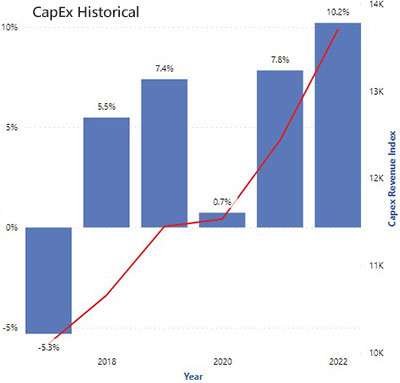

The Manufacturing Execution Systems (MES) for Process Industries Market Research delivers current market analysis plus a five year market and technology forecast. The research is available in multiple editions including worldwide, all regions, and most major countries.
ARC Advisory Group research reveals that Manufacturing Execution Systems (MES) for Process Industries is strategic to intelligence and efficient data-driven decisions. To improve user experience, companies are combining digital technologies including AI, digital twins, augmented and virtual reality, and new low code/no code platforms to streamline and make things simpler and easier to use. Simplified intuitive user experience (UX) is very important and often needs to align to the corporate culture. The ability for workers from anywhere (on-premise, on-site, etc.) to access manufacturing intelligence easily and securely has emerged as another key characteristic. The MES must be easy to deploy, connect and integrate. It must be simple to use, intuitive, and collaborative. The software should be scalable and adapt quickly to new innovative technologies and culture.
 In addition to providing a five-year market forecast, the MES for the Process Industry Research provides detailed quantitative current market data and addresses key strategic issues as follows.
In addition to providing a five-year market forecast, the MES for the Process Industry Research provides detailed quantitative current market data and addresses key strategic issues as follows.
To build an enterprise-wide MES, it is essential to use data standards to connect data to applications across the entire enterprise. To bring different plants’ data together, the MES should include many protocols that support the users’ many applications, equipment, and devices. Some common open standards are: OPC UA (Windows or Linux), OPC DA (Data Access), OPC I, MQTT (Message Queuing Telemetry Transport), AMQP, HTTPS, CoAP, SOAP, REST (Representational State Transfer) APIs (Application Program Interfaces), and IEC (International Electrotechnical Commission) 6180 (e.g., in electrical substations) for connecting to standard data sources and systems (OPC UA leverages MQTT, JSON and is an IEC standard). The most common integration standards are OPC, MQTT, and REST APIs. Also, the ability to easily integrate text files (.csv or .xml) and to integrate other proprietary databases are important. Because there are still many legacy databases, sensors and devices, custom APIs, and SDKs (software development kits) are often necessary. The user should ensure that the software enables the ability to access legacy plant equipment so that data silos are eliminated. The challenge is often to deliver a holistic view of the processes to get an accurate picture of their operations, especially if it involves older assets that are not equipped with sensors or PLCs. Some suppliers have and are working on auto-connection software that automatically senses the type of device and context and connects automatically, minimizing the configuration required.
Companies should also work with standards groups such as Open Group, Open Subsurface Data group to help accelerate open-source technology or tools while protecting the principles and drivers of its community. The group is working to enable data standards for energy providers for collaboration and innovation and avoid fragmentation of data and workflows. ISA-95 and Industry 5.0 groups should also be considered.
Particularly for regulated industries, it is important that MES has traceability and product security. Track and trace in manufacturing begins with the raw materials and end in the warehouse with the final product, enabling manufacturers to track a product from inception to the final product. Track and trace and product security are particularly important in the pharmaceutical & biotech, food & beverages, chemical and other regulated industries.
Hyperscale computing is a distributed infrastructure that can quickly accommodate an increased demand for computing resources without requiring additional physical space, cooling, or electrical power. Hyperscale computing is characterized by standardization, automation, redundancy, high-performance computing (HPC) and high availability (HA). The term is often associated with cloud computing and the very large data centers owned by Facebook, Google, Amazon, and IBM. To accommodate such demand, cloud providers like Amazon Web Services (AWS), Microsoft Azure, and Google Cloud Platform (GCP) have developed new infrastructures that maximize hardware density, while minimizing the cost of cooling and administrative overhead.
Although hyperscaler platforms can handle Industrial IoT data, devices, and applications, the suppliers of this type of technology may lack deep domain expertise for industrial applications that need to robustly solve in-depth functional problems. For this reason, it may be important to look for providers with a strong history and track record in providing industrial software and many of these providers have partnerships with Microsoft, Google, IBM, and AWS.
This market research may be purchased as a MIRA Service, an Excel Workbook, and/or as a Market Analysis Report (PDF). MIRA Services help unlock the full benefits of ARC’s market intelligence, making the data more actionable for you by adding qualitative context to our market data in an online environment unique to each customer. Regional editions include country and industry market data. Formats available are listed below:
| MIRA Services | MIRA Workbook | Market Analysis PDF | |
|---|---|---|---|
| Annual Subscription | Yes | No | No |
| Worldwide (includes regional data) | Yes | Yes | Yes |
| North America (includes regional data) | Yes | Yes | No |
| Europe, Middle East, Africa (includes regional data) | Yes | Yes | No |
| Asia (includes regional data) | Yes | Yes | No |
| Latin America (includes regional data) | Yes | Yes | No |
Table of contents for this research is shown in the following paragraphs.
The research identifies all relevant suppliers serving this market.
List of countries & currencies included in each region: MIRA-Country
To speak with the author or to purchase the Manufacturing Execution Systems for Process Market Research, please contact us.
Learn more about ARC In-depth Research at Market Analysis
Learn more about ARC Strategic Services at Advisory Services for Industry Leaders

